
Is Your Alpha Big Enough to Cover Its Taxes? A 25 Year Retrospective
Deferring taxes is like receiving a free loan from the government.
The tax burden can be reduced by limiting turnover, reducing dividend yield, and investing in smaller, more-tax-aware funds.
Smart beta has emerged as an investment category with the potential to deliver positive alpha after fees and taxes.
Exchange-traded funds provide tax efficiencies that mutual funds lack.
Introduction
Costs matter to every bottom line, and investment management is no exception. Costs—both implicit, such as trading-related market impact costs, and explicit, such as management fees and stated trading costs—lower bottom-line investment returns, and one of the largest costs for any taxable investor is taxes. In the seventh article of our advisor series, we discuss how to identify tax-efficient managers and describe the investment vehicle structures best designed to deliver after-tax alpha. This article draws substantially on the Spring 2018 Journal of Portfolio Management article of the same title written by Rob Arnott, Vitali Kalesnik, and Trevor Schuesler.
Twenty-five years ago in the article “Is Your Alpha Big Enough to Cover Its Taxes?” Tad Jeffrey and I published our findings on the impact taxes have on investment returns. We called this ever present burden on investors “tax alpha,” which is reliably negative. The good news, however, is that now, as then, the tax burden arising from realized capital gains and dividend income is surprisingly easy to shrink. Diligence in deferring capital gains, loss harvesting, lot selection when selling, wash-sale management, holding period management, and other tax-aware strategies can substantially lower the government’s cut of investors’ returns and allow investors to keep more of what their portfolios have earned.
Since 1993, a growing awareness by managers of the importance of tax efficiency, new investment strategies such as smart beta, and innovative investing structures such as exchange-traded funds have all improved investors’ ability to reduce the tax bite into investors’ returns. But other things haven’t changed over the last 25 years. Active managers still have a hard time consistently generating pre-tax alpha, and the fees of active managers are still high. Therefore, for investors to earn the highest possible after-tax return, they and their advisors must consider all additions to, and subtractions from, the following equation:
Gross-of-Fees Return
– Fees
– Income Tax on Dividends and Capital Gains Tax
– Capital Gains Tax After Liquidation
= After-Tax Return
Consequently, an advisor’s ultimate goal should be to shrink the tax-alpha drag on their investors’ portfolios without forfeiting pretax alpha!
Our Findings, a Quarter-Century Ago
Jack Bogle pointed out in 1997 that unrealized capital gains are akin to a free loan from the IRS: deferring the tax liability on a capital gain allows it to grow undiminished to the investment horizon. All else equal, the larger the deferral, the larger the after-tax benefit for the taxable investor. One way to maximize the deferral is to limit portfolio turnover. Turnover is a powerful predictor of a strategy’s tax efficiency because most turnover creates a taxable gain when a security is sold. Investors pay taxes on those realized gains, losing the opportunity to earn a profit on the taxes they paid and did not defer.
Understanding that a positive relationship exists between the size of a portfolio’s unrealized gains (the gap between cost basis and market value) and its pre-tax terminal market value, Tad Jeffrey and I analyzed how turnover affects the after-tax market value of a portfolio. One of our most profound findings was that the marginal impact of taxes is most severe at very low rates of annual turnover. When we assume a starting portfolio value of $100, 6% annual portfolio price appreciation over a 20-year investment horizon, and a 35% capital gains tax rate (similar to current short-term capital gains tax rates, often triggered by the high turnover rates of many mutual funds today), we see that terminal after-tax wealth falls $58 from $320.70 to $262.70 as annual turnover moves from 0% to a low 10%. That loss is larger than the nearly $48 decrease ($262.70 less $214.90) in terminal after-tax wealth when turnover increases from 10% to 100%!
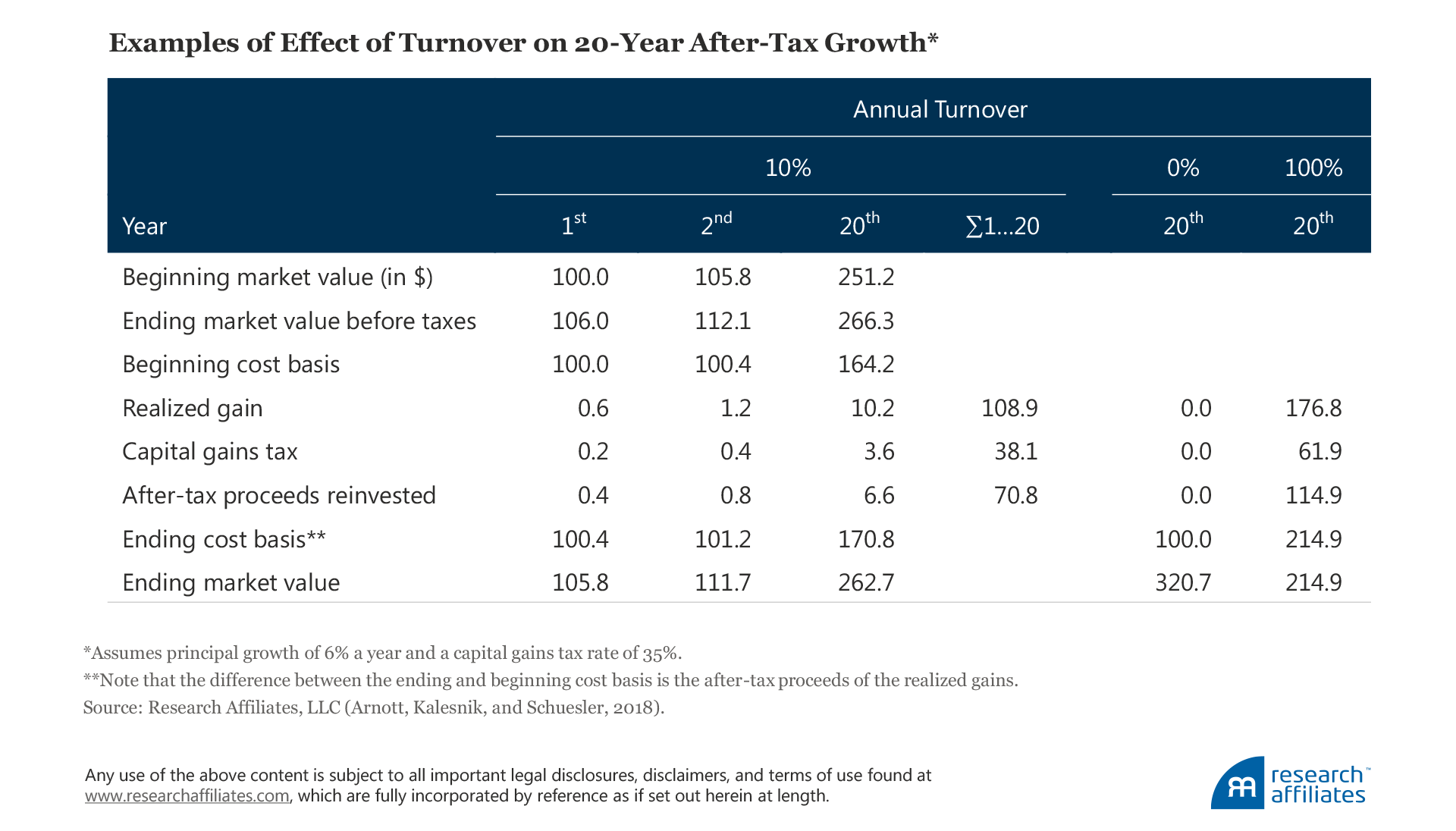
What our research also found was that beating the benchmark is difficult for active managers, after considering fees, and even more difficult after considering taxes. Over the period 1982–1991, only 15 of 71 large active equity mutual fund managers outperformed the Vanguard 500 Index Fund (Jeffrey and Arnott, 1993). After taking capital gains tax and income tax on dividends into consideration, the number of outperforming managers dropped to 9. Investors and their advisors must remember that understanding how best to generate pre-tax alpha is critical, but success on that score is for naught if the impact of taxes is ignored or poorly managed.
What’s New Since 1993
Tax-advantaged investing is now a well-established part of the asset management business—although not nearly as large as it should be! Many techniques allow us to defer taxes with relatively little detriment to a fund’s pre-tax performance, but sadly they command only a small niche in an enormous industry. Some of these strategies are:
- Deferral of capital gains—deferring sales as along as possible to avoid realizing capital gains and triggering the related tax liability.
- Loss harvesting—selling assets whose market value is lower than their cost basis to realize a capital loss, which can offset realized gains on other assets at the present time or in the future.
- Lot selection—selecting a particular holding (or lot) of an asset with the cost basis that produces the best tax outcome, when a position in an asset is being reduced.
- Wash-sale management—coordinating among portfolio managers under a single administrator to transfer assets to avoid violating the wash-sale rules.1
- Holding-period management—choosing when to sell an asset to get the most favorable capital gains tax treatment.
- Yield management—selecting low-yield stocks because they incur lower taxes than high-yield stocks.
Today, tax-aware investing, as compared to the more aggressive forms of tax-advantaged investing, composes a much larger segment of the asset management arena. In tax-aware, as compared to the more aggressive forms of tax-advantaged investing, managers do not have a systematic process to objectively and aggressively manage the tax consequences of their investment decisions. As a result, these managers may capture some of the benefit of tax-advantaged investing, but prioritize the quest for an uncertain and all-too-often negative pre-tax alpha ahead of the quest for a predictable and manageable reduction in the drag associated with reliably negative tax alpha.
Over the last 25 years, three other notable and positive changes that impact taxable portfolios have taken place. First, advisors, consultants, and investors are all much more aware of the importance of seeking to maximize after-tax returns. Second, the introduction of exchange-traded funds (ETFs) and exchange-traded notes (and to a lesser extent long-dated swaps) now offer investors a powerful tool for tax efficiency. These structures are designed to allow the deferral of capital gains taxes—typically at lower long-term rates—until the investment vehicle is sold. Third, smart beta strategies, which offer very low turnover, large capacity, and a rebalancing alpha that seems robust, are charting a new path to after-tax alpha.
What Hasn’t Changed Since 1993
An analysis of the data over the last quarter-century highlights the fact that two things haven’t changed since 1993: persistent alpha is still fleeting, and active manager fees are still high. The evidence shows that the capitalization-weighted index is still hard to beat for most active managers. According to data from SPIVA® (S&P Dow Jones Indices Versus Active), over the 10-year horizon ending December 31, 2017, 82.4% of US large-cap funds underperformed the S&P 500 Index and 84.2% underperformed over the 5-year horizon ending December 31, 2017.
Manager fees, easily tracked and understood by investors, are still high at slightly over a 1.00% average expense ratio for actively managed funds (Arnott, Kalesnik, and Schuesler, 2018). Higher fund expenses, including, of course, manager fees, are associated with worse performance. In 2003, Jack Bogle wrote about the cost matters hypothesis as he called it, concluding that “whether markets are efficient or inefficient, investors as a group must fall short of the market return by the amount of the costs they incur.” Passive index funds were launched in large part to lower manager fees and, in practice, actually improved after-fee performance. Bogle (1997) found that passive managers, even after fees, performed as well as the top quintile of active managers.
In Arnott, Kalesnik, and Schuesler (2018), we compared the evolution of fund expense ratios for active, passive, and smart beta funds over the period from January 2007 through December 2016. Where the costs were already low, the fee pressure has been higher—the average expense ratio for active funds declined 9% from 112 bps to 102 bps over the period, and the expense ratio for passive funds declined 15% from 46 bps to 39 bps.
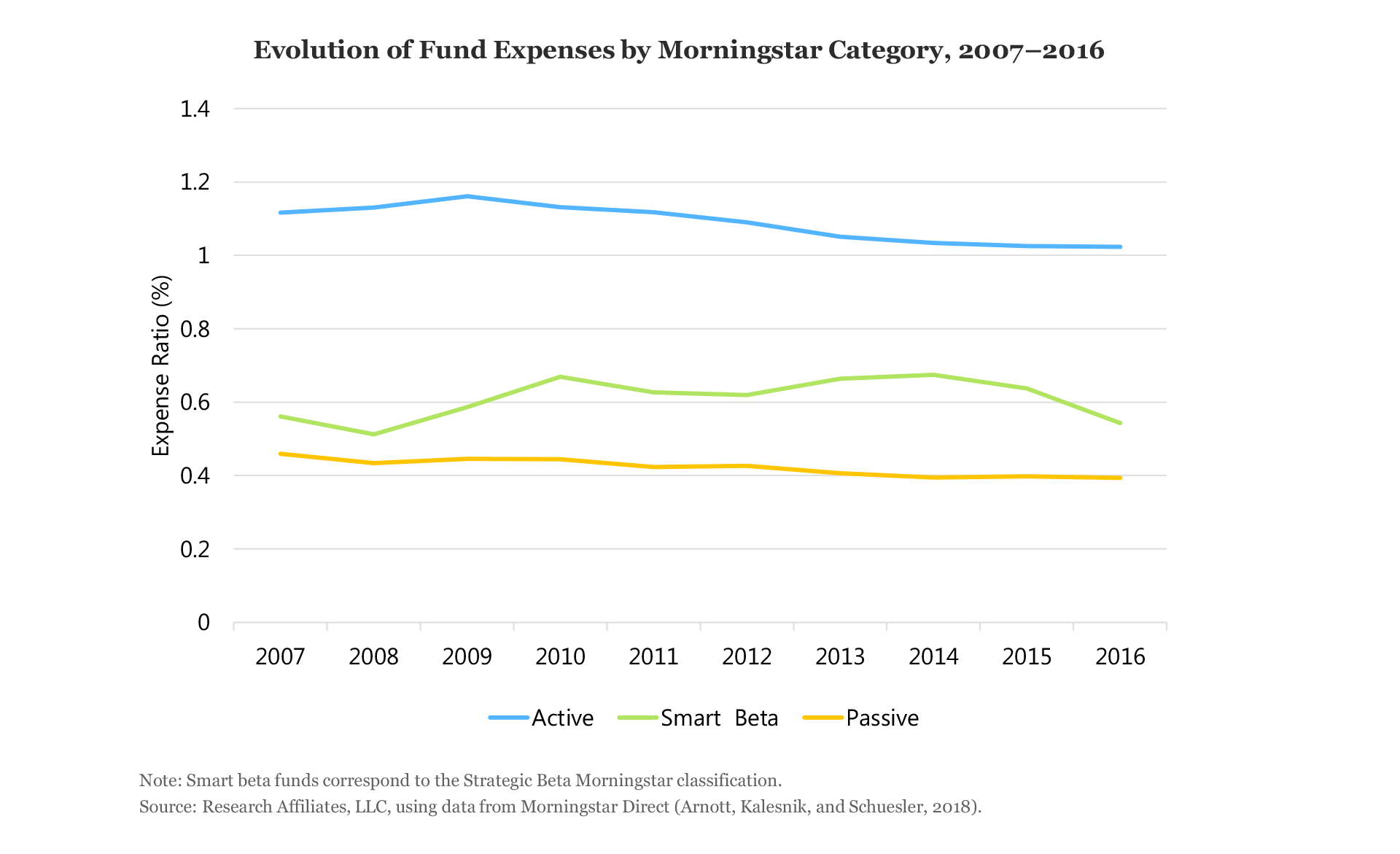
The distributions of the expense ratios for the three categories display sharp differences. The majority of the active mutual funds (65%) have expense ratios in the range of 76 bps to 125 bps, whereas the majority of passive index funds (73%) have expense ratios below 50 bps. Smart beta funds’ expense ratios display a more bimodal character with 62% having expense ratios less than 50 bps and 23% above 100 bps; the smart beta funds with expense ratios under 100 bps follow a frequency distribution quite similar to that of the passive index funds.
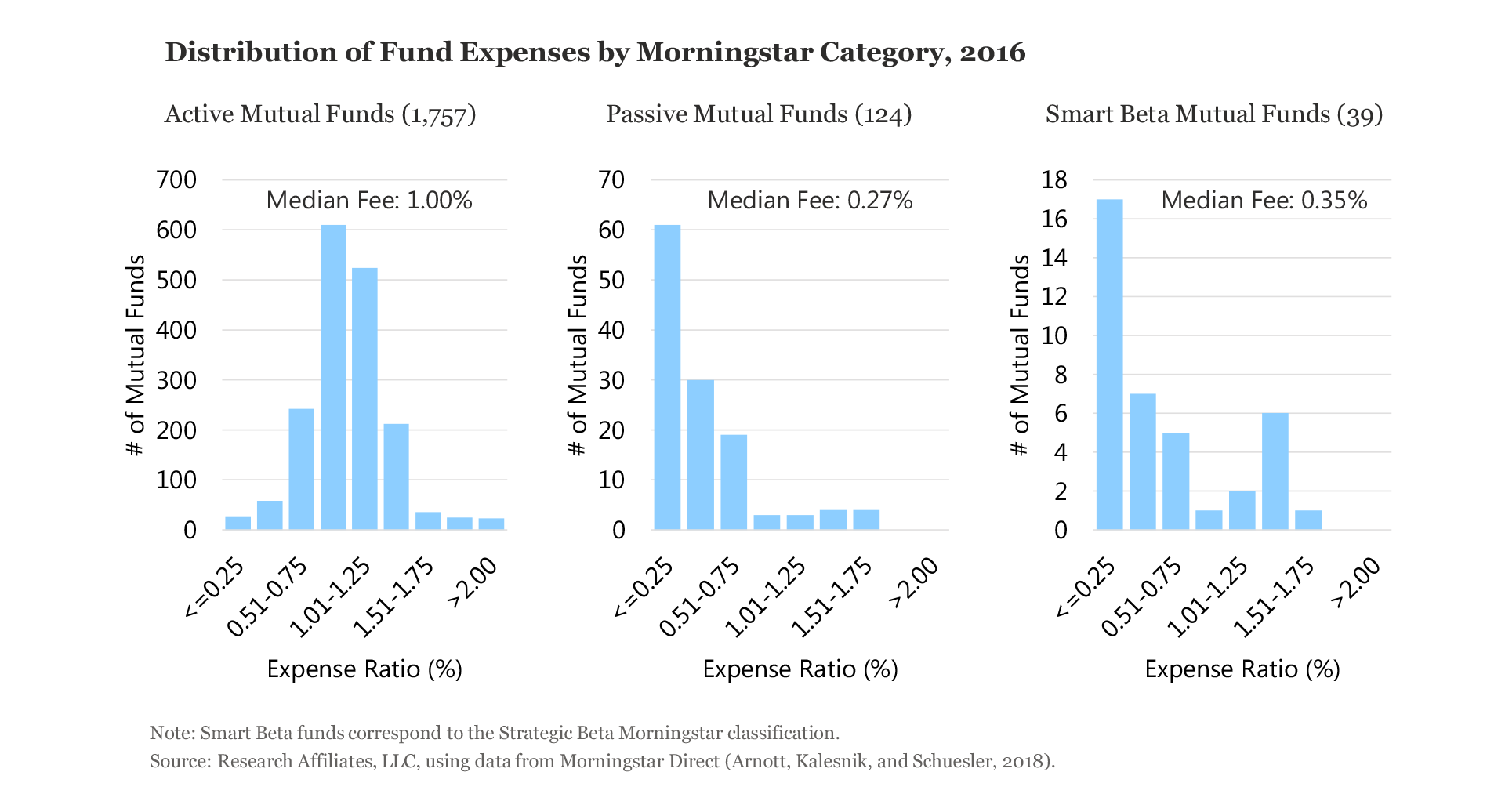
The Goal: Finding Tax-Efficient Managers
Given that finding managers who can generate pre-tax alpha is not an easy task, adding the hurdle of tax efficiency to a manager’s repertoire creates an even more daunting task. In Arnott, Kalesnik, and Schuesler (2018), we found that higher gross returns, higher turnover, and higher dividend yields all lead to higher tax burdens.2So how can advisors and investors apply our findings to allocate to the most tax-efficient fund managers and strategies, which have the ability to deliver the highest after-tax returns to their investors?
To answer this question, we looked at more than 4,000 US-benchmarked mutual funds and ETFs with at least two years of live history in the Morningstar Direct database from January 1993 through December 2017, categorizing the sample into four groups—active, passive, factor, and smart beta funds—based on keywords that describe the fund’s strategy.
Focusing on the 10-year period ending 2017,3 we found that all fund types (active, passive, factor, and smart beta, as defined by Morningstar) beat their benchmarks, on average, gross of fees and taxes (although these results are influenced by survivorship bias), but active and factor funds did so with high fees and poor tax efficiency, leading to returns that trailed their benchmarks by about 2% after fees and taxes. In comparison, passive funds performed in line with active and factor funds gross of fees, but outperformed those same funds by 0.6–0.7% after fees and taxes.
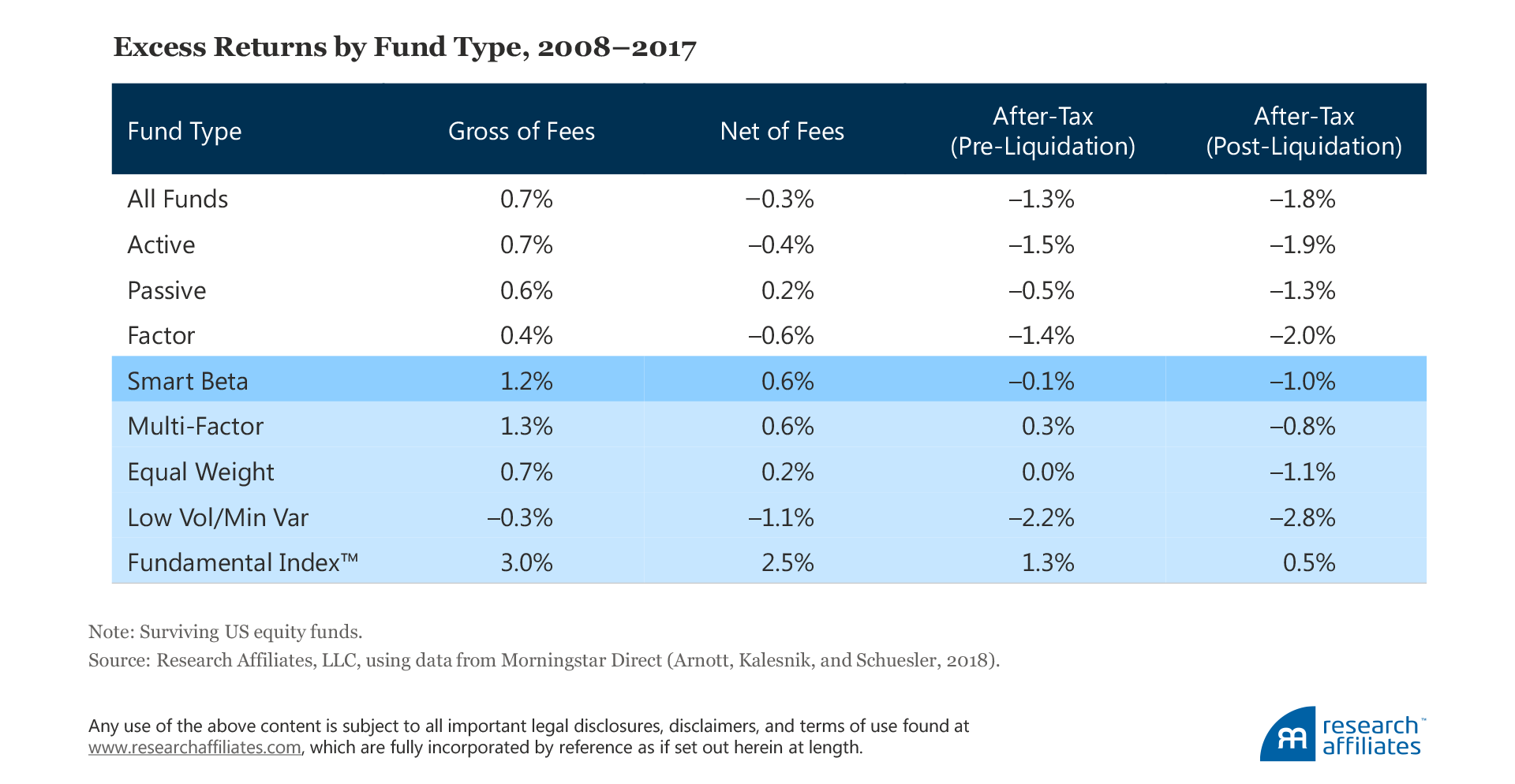
Not unsurprisingly—based on our experience—smart beta funds fared the best, both before and after tax. This outperformance occurred despite recent headwinds buffeting value strategies, a common trait shared by many smart beta funds. Their success we believe is a byproduct of a structure and process that systematically captures excess returns in a low-cost, tax-efficient manner. Not all smart beta funds are created equal, however, so investors must choose carefully! For example, from 2008 to 2017, low vol funds performed about 0.9% worse than active funds while the Fundamental Index™ strategy performed about 2.4% better.
Tax-Efficient Investment Vehicles: ETFs and Beyond
For a taxable investor, the ETF may be the most important innovation in investment structure that has emerged over the last quarter-century, with smart beta—at least in its narrow original definition of severing the link between the price of a stock and its weight in the portfolio—a close second.
Compared to a mutual fund, an ETF has lower fees and is able to defer capital gains, and the tax liability associated with those gains, much more efficiently. Over the entire 25-year period we studied (Arnott, Kalesnik, and Schuesler, 2018), 53.3% of ETFs made no capital gain distributions whatsoever, while only 4.9% of mutual funds could boast such strong tax-efficient behavior. The low rate of capital gains distributions meant that none of the ETFs generated a tax burden higher than 1% in capital gains tax alpha compared to the 40.2% of mutual funds that did so.
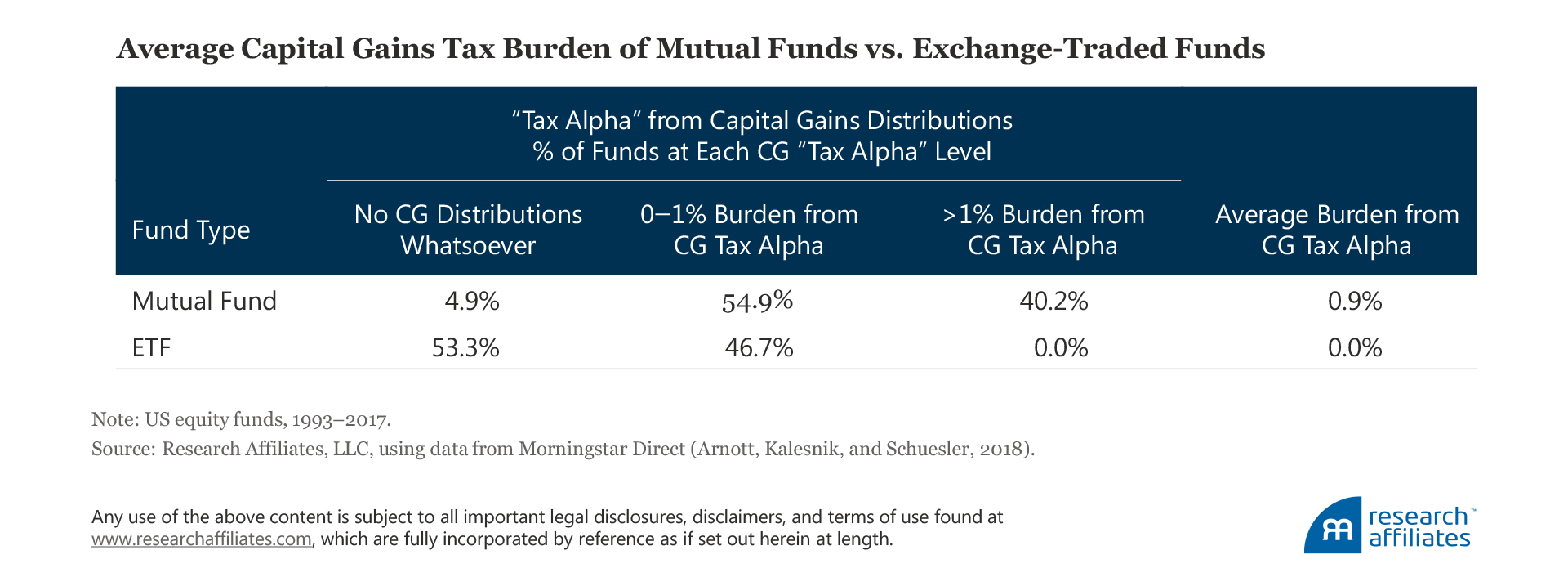
An ETF’s tax efficiency remains after considering the taxation of dividend income. Nearly half of the mutual funds we studied had distributions that generated a tax burden in excess of 1%, leading to a 0.8% worse tax alpha for mutual funds.
Conclusion
Management fees, the investment industry’s most visible cost, often get more attention than the less visible and typically larger costs associated with trading and taxes. Investors and their advisors must be alert to managing both pre-tax and after-tax alpha in order for investors to realize the highest possible return from their taxable portfolios. Increasingly, the opportunities to accomplish both goals are within reach of investors as more managers are becoming tax aware and new, innovative strategies—in particular smart beta—and investing vehicles, such as exchange-traded funds, have entered the market over the last quarter-century. Advisors can best serve the needs of their clients when they recognize that the quest for pre-tax alpha goes hand in glove with careful management of the tax consequences of portfolio management decisions.
Endnotes
- A wash sale occurs when an investor sells or trades securities at a loss and within 30 days after the sale buys substantially identical securities, acquires substantially identical securities in a fully taxable trade, or acquires a contract or option to buy substantially identical securities. US Internal Revenue Service rules prohibit the deduction of losses related to wash sales.
- In the 2008–2017 period, larger funds also lead to higher tax burdens, but analyzed over the longer 25-year period, using a year-by-year test, fund size loses its statistical significance.
- Separate tests were performed on all sample funds, both surviving and non-surviving, and also on only those that survived the entire 25-year and 10-year periods. The tests on the full sample focuses on after-tax returns before liquidation because the funds have different start and end dates. The tests on the surviving funds can be performed taking liquidation and the resulting capital gains taxes into consideration. More information on the data sample is available in Arnott, Kalesnik, and Schuesler (2018).
References
Arnott, Rob, Vitali Kalesnik, and Trevor Schuesler. 2018. “Is Your Alpha Big Enough to Cover Its Taxes? A Quarter-Century Retrospective.” Journal of Portfolio Management, vol. 44, no. 5 (Spring):78–102.
Bogle, John. 1997. “Mutual Funds: Parallaxes and Taxes.” Remarks at the Association for Investment Management and Research (November 12).
Bogle, John. 2003. “Whether Markets Are More Efficient or Less Efficient, Costs Matter.” CFA Magazine, vol. 14, no. 6 (November/December).
Jeffrey, Robert, and Robert Arnott. 1993. “Is Your Alpha Big Enough to Cover Its Taxes?” Journal of Portfolio Management, vol. 19, no. 3 (Spring):15–25.

